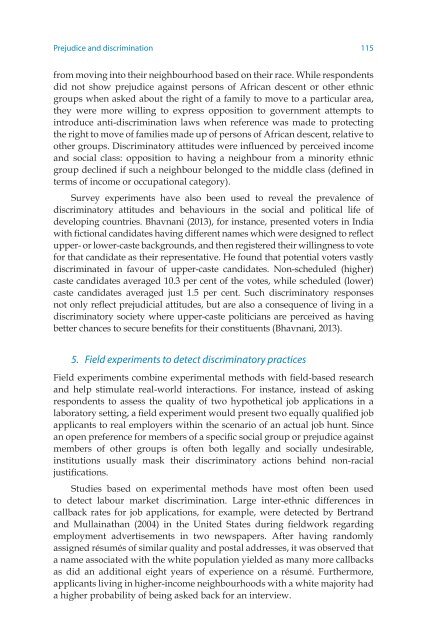Leaving no one behind the imperative of inclusive development
full-report
full-report
Create successful ePaper yourself
Turn your PDF publications into a flip-book with our unique Google optimized e-Paper software.
Prejudice and discrimination 115<br />
from moving into <strong>the</strong>ir neighbourhood based on <strong>the</strong>ir race. While respondents<br />
did <strong>no</strong>t show prejudice against persons <strong>of</strong> African descent or o<strong>the</strong>r ethnic<br />
groups when asked about <strong>the</strong> right <strong>of</strong> a family to move to a particular area,<br />
<strong>the</strong>y were more willing to express opposition to government attempts to<br />
introduce anti-discrimination laws when reference was made to protecting<br />
<strong>the</strong> right to move <strong>of</strong> families made up <strong>of</strong> persons <strong>of</strong> African descent, relative to<br />
o<strong>the</strong>r groups. Discriminatory attitudes were influenced by perceived income<br />
and social class: opposition to having a neighbour from a mi<strong>no</strong>rity ethnic<br />
group declined if such a neighbour belonged to <strong>the</strong> middle class (defined in<br />
terms <strong>of</strong> income or occupational category).<br />
Survey experiments have also been used to reveal <strong>the</strong> prevalence <strong>of</strong><br />
discriminatory attitudes and behaviours in <strong>the</strong> social and political life <strong>of</strong><br />
developing countries. Bhavnani (2013), for instance, presented voters in India<br />
with fictional candidates having different names which were designed to reflect<br />
upper- or lower-caste backgrounds, and <strong>the</strong>n registered <strong>the</strong>ir willingness to vote<br />
for that candidate as <strong>the</strong>ir representative. He found that potential voters vastly<br />
discriminated in favour <strong>of</strong> upper-caste candidates. Non-scheduled (higher)<br />
caste candidates averaged 10.3 per cent <strong>of</strong> <strong>the</strong> votes, while scheduled (lower)<br />
caste candidates averaged just 1.5 per cent. Such discriminatory responses<br />
<strong>no</strong>t only reflect prejudicial attitudes, but are also a consequence <strong>of</strong> living in a<br />
discriminatory society where upper-caste politicians are perceived as having<br />
better chances to secure benefits for <strong>the</strong>ir constituents (Bhavnani, 2013).<br />
5. Field experiments to detect discriminatory practices<br />
Field experiments combine experimental methods with field-based research<br />
and help stimulate real-world interactions. For instance, instead <strong>of</strong> asking<br />
respondents to assess <strong>the</strong> quality <strong>of</strong> two hypo<strong>the</strong>tical job applications in a<br />
laboratory setting, a field experiment would present two equally qualified job<br />
applicants to real employers within <strong>the</strong> scenario <strong>of</strong> an actual job hunt. Since<br />
an open preference for members <strong>of</strong> a specific social group or prejudice against<br />
members <strong>of</strong> o<strong>the</strong>r groups is <strong>of</strong>ten both legally and socially undesirable,<br />
institutions usually mask <strong>the</strong>ir discriminatory actions <strong>behind</strong> <strong>no</strong>n-racial<br />
justifications.<br />
Studies based on experimental methods have most <strong>of</strong>ten been used<br />
to detect labour market discrimination. Large inter-ethnic differences in<br />
callback rates for job applications, for example, were detected by Bertrand<br />
and Mullainathan (2004) in <strong>the</strong> United States during fieldwork regarding<br />
employment advertisements in two newspapers. After having randomly<br />
assigned résumés <strong>of</strong> similar quality and postal addresses, it was observed that<br />
a name associated with <strong>the</strong> white population yielded as many more callbacks<br />
as did an additional eight years <strong>of</strong> experience on a résumé. Fur<strong>the</strong>rmore,<br />
applicants living in higher-income neighbourhoods with a white majority had<br />
a higher probability <strong>of</strong> being asked back for an interview.
















